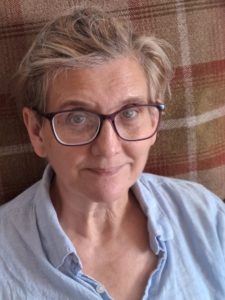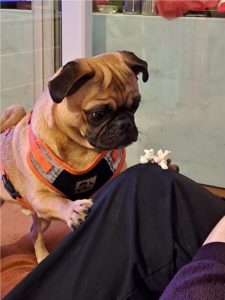2023 marks twenty years of Organic & Biomolecular Chemistry publications. As part of the celebrations, OBC has invited some of the most prominent authors across our history to give their thoughts on the last twenty years of their career alongside their predictions for the next two decades.
The next entry to the series comes from Professor Alexandra Slawin, recently retired from the University of St. Andrews who’s first contribution to OBC was in 2003, the journal’s first year. She continued to bring her X-ray crystallography expertise to 43 research papers published in the journal across the years, most recently in 2023.
About Alex
 Alex Slawin was born in Taunton in 1961 where she went to Bishop Fox School. She started her academic journey as an undergraduate at Imperial College in 1980, moving to Loughborough University to start an independent career and establish a chemical crystallography lab. In 1999 she moved to St Andrews where she was promoted to Professor in 2002 – the first female Professor of Chemistry in the University of St Andrews. She was there over 20 years, having worked at Imperial and Loughborough before. In 2013 she was recognised as a rare woman with over 50 papers in Angewandte Chemie and in 2014 she published her 1000th paper.
Alex Slawin was born in Taunton in 1961 where she went to Bishop Fox School. She started her academic journey as an undergraduate at Imperial College in 1980, moving to Loughborough University to start an independent career and establish a chemical crystallography lab. In 1999 she moved to St Andrews where she was promoted to Professor in 2002 – the first female Professor of Chemistry in the University of St Andrews. She was there over 20 years, having worked at Imperial and Loughborough before. In 2013 she was recognised as a rare woman with over 50 papers in Angewandte Chemie and in 2014 she published her 1000th paper.
She was a fellow of the RSC and RSE before retiring and stopped paying the subscriptions and is the highest ranked female on the Cambridge Crystallographic Data Centre (the international depository for X-ray structures). She has published over 1500 peer reviewed papers and has an internationally leading research profile. Whilst her children were at school in St Andrews, Alex was on the PTA then the Parent Council for Madras College in a variety of capacities. She was the manager for technicians in the School of Chemistry for a number of years and has been a pastoral advisor there for almost all her time there. Just prior to retirement, she trained (formally) to be mediator with the Mediation partnership, and was a member of the University Mediation service, participating in external and internal mediations. She has 3 children ages 29-33 so had informally mediated for many years. She retired in 2022 intending to go into dog advertising as she felt her son’s dog was endearing enough to make big bucks but decided very quickly that was a bad move.
First OBC paper: C. J. Moody, A. M. Z. Slawin & D. Willows, Dirhodium(ii) tetraacetate catalysed reactions of diazo thioamides: isolation and cycloaddition of anhydro-4-hydroxy-1,3-thiazolium hydroxides (thioisomünchnones), an approach to analogues of dehydrogliotoxin, Org. Biomol. Chem., 2003, 1, 2716-2722, DOI: 10.1039/b305698h
Most recent OBC paper: A. Giannoulis, K. Ackermann, A. Bogdanov, D. B. Cordes, C. Higgins, J. Ward, A. M. Z. Slawin, J. E. Taylor & B. E. Bode, Synthesis of mono-nitroxides and of bis-nitroxides with varying electronic through-bond communication, Org. Biomol. Chem., 2023, 21, 375-385, DOI: 10.1039/d2ob01863b
Favourite OBC paper: F. N. Palmer, F. Lach, C. Poriel, A. G. Pepper, M. C. Bagley, A. M. Z. Slawin & C. J. Moody, The diazo route to diazonamide A: studies on the tyrosine-derived fragment, Org. Biomol. Chem., 2005, 3, 3805-3811, DOI: 10.1039/b510653b
How did your research on organic systems structural determination develop over the last 20 years?
I have been a crystallographer since my final year as an undergraduate, and back then structures were principally the domain of the inorganic chemist – although organic structures were solved, it was mainly inorganic and organometallic chemists that used the results of X-ray crystallography. The advent of cheap computing and many clever algorithms to utilise crystallographic methods meant that the use of X-ray crystallography in – as it were – ‘pure’ organic chemistry to solve light atom structures and to give absolute structure determinations became possible. Since I started with just 1 Cu machine at Imperial college, I always utilised Cu radiation and when I could afford to expand, I added Mo. Back then preferring copper radiation was unusual, and occasionally I would get referees saying I should recollect using Mo, even if the crystal I had available to me were too small to be usefully collected with Mo radiation. Instead of celebrating we had really great results, the focus was on how they thought it could be ‘better’ – as if I wouldn’t want to try publishing the best I had done, rather than just shoving in any old result.
How has X-ray crystallography as a tool in organic chemistry changed over the last 2 decades?
Much of what I said above, applies to this. I suppose the real change is that organic chemists are now used to being able to get results with smaller crystals, get absolute structure determination, marry up the results with other techniques. For instance, for a couple of groups, I would run a crystal that gave an absolute structure determination, save the crystal and transfer it to a vial. Then they would take that crystal and do clever NMR experiments on what could be a very small sample size in order to show that the absolute structure could verify the NMR results of not only that particular structure but perhaps a whole string of results. Although you would have to speak to the chemists about that – in the altered words of Austin Powers “NMR is not my bag”.
Where do you foresee the challenges being in this area over the next 20 years?
Oh, if I could answer that accurately I would be using my powers to live in a tax haven such as Bermuda – where actually one of my sons does live legitimately (he’s an actuary). So maybe my answer would be to quit chemistry and go into finance, which actually might help one finance the ongoing costs of obtaining, running and maintaining high end research equipment in the face of spiralling energy costs, decreasing public interest and fashions in chemistry that bend not according to scientific need but to political initiatives. The challenges in the area I spent my working life in are not that different to all ongoing challenges in science and it needs people with passion and interest to keep going against the system rather than going with it. I am now of an age where I didn’t feel like keeping up the fight so have retired to spend my energy doing things I enjoy, rather than struggle against stuff.
A word on the paper you selected as your favourite in OBC
For my favourite paper I have picked one I collaborated on with Chris Moody on an early structure from the Rigaku Rotating anode/CCD system which was a small pure organic crystal collected using Mo radiation. He was a lecturer at Imperial when I was an undergraduate, I started my independent career at Loughborough when he was Head of School there and we carried on collaborations after he and I both moved to different locations. There are very many people I had long and fruitful collaborations with, but I feel Chris’ contributions are sometimes overlooked.
Check out the other entries in our blog series here!











